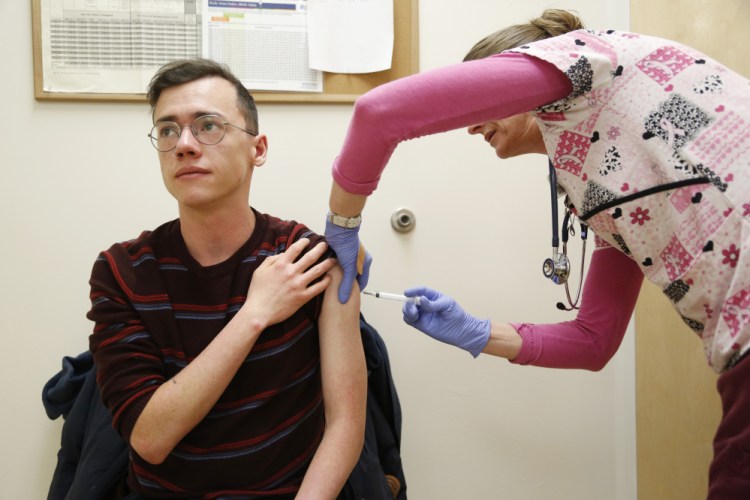Flu season is underway, and although Maine so far is experiencing fewer cases of seasonal flu than most states, the predominant strain of influenza circulating in Maine and most of the U.S. is more severe than last year and more likely to require hospitalization.
The Maine Center for Disease Control and Prevention reported 373 cases of flu through Dec. 23, the latest data available, with 99 hospitalizations. Flu is currently widespread in some southern and western states, including Texas, Alabama, South Carolina and Arizona, but has so far spared New England.
Nationally, there were 13,475 reported flu cases through Dec. 16, according to the U.S. Centers for Disease Control and Prevention. Last season, national numbers were about 120,000 reported cases, although the actual number is much higher because many cases of flu are not reported if the symptoms are not severe and the patients recover without seeing a doctor.
Flu season runs from October to May, and is unpredictable.
Last year, for instance, there were only 52 flu cases in Maine through Dec. 24 and 467 through the end of January, but cases surged in the last three months of the season. The state ended up with 5,830 reported cases of flu in 2016-17, more than twice the previous year’s total.
Fourteen percent of cases required hospitalization in 2016-17, compared with 26 percent so far this season.
Dr. Siiri Bennett, state epidemiologist for the Maine CDC, said that “the large bulk of what we’re seeing is influenza A (H2N3), which is more serious and more likely to cause hospitalizations and deaths, especially among those over 65 and young children.”
In Maine, about 55-60 percent of flu cases in 2015-16 were influenza A, with the remainder influenza B, but so far this flu season about 80-90 percent of cases are influenza A.
Bennett said it’s difficult to say whether there will be a sudden explosion in cases – like there was last spring – or a steady stream, or if flu cases would decline this spring.
“It’s still too early in the season to say what flu season will be like,” Bennett said. “It’s certainly not too late to get vaccinated.”
Vaccines are widely available – at drugstores, primary care physicians’ offices and some workplaces, and are usually free for patients.
Part of the calculation is how effective the vaccine is from year to year, as CDC scientists try to predict what the most common strains of flu vaccine will be circulating.
“It’s always a little bit of guesswork,” Bennett said.
The federal CDC’s website says it’s too early in the season to determine how effective the vaccine is this year. Reports that it’s only 10 percent effective are likely not true because that was news from Australia, and the more valid comparison is to historical trends in the U.S., according to the CDC.
“It’s not possible to predict with certainty if the flu vaccine will be a good match for circulating flu viruses,” the website says. “The flu vaccine is made to protect against the flu viruses that research and surveillance indicate will likely be most common during the season. However, experts must pick which flu viruses to include in the flu vaccine many months in advance in order for flu vaccines to be produced and delivered on time. Also, flu viruses change constantly (called drift) – they can change from one season to the next or they can even change within the course of one flu season.”
The vaccine was 48 percent effective in 2016-17 and 59 percent effective in 2015-16, according to the CDC.
For those who get vaccinated, if they do still contract the flu, it will most likely be a milder version than those who do not get immunized, according to the CDC.
State Sen. Brownie Carson, D-Brunswick, said he’s concerned that Maine still doesn’t have enough public health nurses on hand if a flu epidemic were to break out this season. The number of Maine public health nurses plummeted from more than 50 several years ago to about 25 in 2017.
A bill approved by the Legislature over Gov. Paul LePage’s veto requires that Maine have at least 50 public health nurses. Carson said he’s “encouraged” to see the Maine Department of Health and Human Services advertise for public health nursing positions and hopes they will be filled soon. The nurses were instrumental in Maine during the H1N1 flu outbreak in 2009, when vaccine clinics were set up all over the state, Carson said.
“It would not only be helpful, but absolutely crucial to fill these positions,” he said. “The field nurses are extraordinarily stretched thin right now.”
Send questions/comments to the editors.




Comments are no longer available on this story